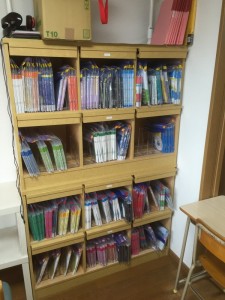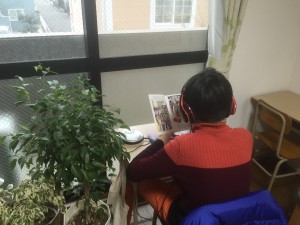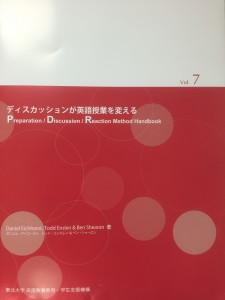Amazon Kindle
An interesting possibility
I’ve been a big fan of reading Kindle ebooks for a while now, but so far I have done all my reading on my iPhone. I bought a couple of the earlier Kindle eReaders but never liked them: the page turning, the form factor, something about them just wasn’t as good as reading on my phone so I didn’t use them much.
Last week though, Amazon were doing a deal where the latest Kindle was 5,000 yen off, so I picked one up for under 4,000 yen.
And loved it. It’s light, the screen looks great, and the pages turn in a pleasing manner. It’s a bit too easy to touch it by accident, but not a deal-breaker.
So far, so good. It’s a nice device, and the prices are coming down so fast that these things are practically disposable now.
And that’s what hit me. On Thursday as I was showing some teachers around the Academy, it struck me that Kindle could be the answer to our high-level book problem.
You can sync multiple devices to the same account (my account is linked to a dozen: computers, smartphones, tablets, and all those old Kindles).
So instead of buying hundreds of paper books that are going to lie around taking up shelf space and rarely being read, I could buy books on my Kindle account, buy a couple of Kindles for the Academy, sync them to my account, and lend them to our students. Heck, at 3,000 yen each we could just give them to the students 🙂
I already have close to 1,000 books on there (although 90% of them are fantasy, science fiction, personal finance, productivity, or teaching) and it would be easy to pick more up as needed.
The school would appear funky, students would probably appreciate the novelty, and we wouldn’t need anywhere near as much space for marginal books.
What do you think? Genius or what?
The Academy Program
English Program for Junior and Senior High School Students
For the last two years we have been developing the Cambridge Academy, an academic English program for junior and senior high school students in a private English school setting.
The program consists of two strands: input and output.
Input classes are based on extensive reading and listening. Students spend most of their time reading/listening to graded materials at their level. Students also learn vocabulary, do shadowing, or write short reactions to books (at higher levels).
Output classes are focused on oral and written production. Students work in pairs to develop their speaking fluency, and do intensive reading and listening exercises to encounter and practice language. Vocabulary and grammar is chosen to complement public junior high school textbooks.
We are now exploring ways to license and share the Academy program with other schools. Academy partner schools will receive training, teaching and administration manuals, and materials, and have the option to purchase starter packs of readers (labelled and organized into packs so they can be used straight out of the box).
Many English schools struggle with retaining and recruiting junior and senior high school students. The Academy program provides practical, academically focused classes that are easy to run, enjoyable for teachers and students, and easy to explain to parents.
If you are interested in learning more or would like to be considered as a test partner please get in touch via email or a comment below.
curriculum expectations high school junior high school school management
by sendaiben
2 comments
Making a New JHS and SHS Curriculum
Fluency Practice and Clarity
This year we are creating a new curriculum for the Cambridge Academy output classes. I’ve written (and thought) a lot about the Academy reading program input classes, but over 90% of our students also take an output class.
Output classes are small group (up to six students) communication classes focusing mainly on speaking and writing. This year I am taking a closer look at these classes because I have noticed that they may be far more important than I realized.
I believe the reading program delivers most of the benefit to our students. Extensive reading and listening for at least an hour a week is going to complement everything else they are doing at school and outside and give them the amount of input they need to start internalizing the language. However, in our input classes students work alone reading and listening to texts. They don’t necessarily notice the progress they are making, nor do they form emotional connections with their classmates or teachers.
That’s where the output classes come in. Students do pairwork and communicate through speaking and writing. If they enjoy the output classes they will be more motivated and have a positive view of our school.
In a way, the output classes are the heart of the program.
Which is why we are trying to improve them this year. Last year the output classes were a bit of an afterthought, and did not produce the results or the atmosphere we wanted. This year we are shaking things up with some major changes.
No homework
Two things prompted this: I read some articles about how homework doesn’t do much for students and they really resonated with me, and we noticed that only about half of our students were actually doing the homework we set.
Now, I think the benefits of formal homework could be debated, but for us the negative aspects of students not doing homework were far more important. First of all, it was very disruptive to have some students do the homework and others not. We had to take class time to help them catch up at which point that students that actually did the homework got annoyed. Asking/nagging students about homework also created a negative atmosphere in the class, and made some students not want to come to class merely because they felt bad about not doing the homework.
This is why from this month we will not be setting formal homework in our Academy classes. Students have self-study they can do (extensive reading and listening, vocabulary study with Word Engine, listening practice with elllo) but nothing compulsory.
The no homework policy is going well so far.
Fluency practice for speaking and writing
This came from reflecting on university classes based on the PDR method, as well as Yuko Suzuki’s take on shadoku. I have come to believe that our students need fluency practice, ie doing relatively easy linguistic tasks in order to acquire automaticity. What this looks like in practice is doing question and answer drills, timed writing, and repeating speaking activities multiple times.
Again, based on a couple of weeks: better atmosphere, happier students, more satisfied teachers. We’ll see how it goes as students get over the novelty and potentially start getting bored over the next few months.
The Longterm Plan
In the longterm I would like to create an original curriculum for junior and senior high school students that doesn’t require commercial textbooks, based on the principles we are exploring in our output classes. Such a curriculum could be useful not only to Cambridge Academy, but potentially to other private language schools and even junior and senior high schools interested in running a communication class once a week.
More details as this project progresses.
curriculum extensive listening extensive reading Language learning speaking
by sendaiben
12 comments
Shadoku Explained
Adding shadowing to beginner extensive reading has immense potential
I’ve been meaning to write this post for a while. I’d like to thank Yuko Suzuki, who first told me about the huge potential of incorporating shadowing practice into extensive reading classes for beginners/lower-level students. If you have a chance to see one of her presentations I recommend you take it -she’s a very effective teacher and presenter.
So what is shadoku? Well, it is a term coined by me as a gag over lunch at a seminar in Fukuoka. I’m kind of chuffed that it has been adopted somewhat by the community 😉
Shadoku is shadowing and tadoku (extensive reading).
Shadowing is a type of speaking fluency practice that involves attempting to speak along with another person or an audio source. It is different from repeating. When doing read and repeat, for example, the source would speak first, then the learner would repeat. In shadowing, the source would speak, then the learner would attempt to say the same thing at the same time with the smallest lag possible. One feature of shadowing is that learners are encouraged to imitate the speaker’s tone, intonation, emotion, and pronunciation.
This video gives a brief explanation of shadowing.
So how does this work with tadoku (extensive reading)?
Well, I have only been experimenting with this for a few months, and we rolled it out to all the beginner students in the Cambridge Academy last week.
I have adapted (messed up?) Yuko’s technique slightly, so I will introduce my version of shadoku below.
For beginners (mainly junior high school first years and elementary students) I am planning to do shadoku as described below until they reach YL 0.4, at which point I may allow them to read and listen instead, or we may continue with shadoku if that seems appropriate at the time. Basically this year is another learning experience for me.
How to do shadoku
There are four steps in my version of shadoku, so a student will read each book four times.
Step one: look at the pictures, think about the content. At YL0.1-0.3 there are plenty of pictures in the books and students can guess a lot of the content just from that. This step takes a minute or two, and we encourage students to look closely at details in the pictures.
Step two: listen to the audio and read along silently. This step allows students to focus on how to pronounce words and how the English sounds when spoken.
Step three: listen to the audio, read along, and shadow out loud. This step allows students to shadow assisted by the text.
Step four: listen to the audio and shadow out loud. Do not open the book. This step allows students to use their listening skills and short-term memory to shadow successfully. I also encourage students to think about the meaning of what they are saying during this step.
Introducing shadoku
For the first three or four classes I have students do shadoku as a group, with me leading them. I introduce each step (I have a notebook with the four steps that I show to remind students), play the CD when necessary, and give students feedback and advice. Students shadow together as a group, which makes them feel less self-conscious and allows more confident/keener students to set a good example.

I use these diagrams to explain shadoku
After a few classes and once students are more confident, we do group shadoku at the beginning of class and then students work individually with headphones and personal CD players in the latter half. They are also expected to continue practicing in the same way at home.
The benefits of shadoku
I haven’t been using shadoku with my students for long, but already I am really happy with how things are going. I’ve been asking all our new students (starting at YL 0.1) to do shadoku, and am currently planning to have them continue until they reach YL 0.4 or so.
The main benefit is that students are much more involved in the task.
Previously when we did reading while listening some students were clearly zoning out. I had a couple who appeared not to have made any progress mid-year so I had to have them go back to the beginning and do intensive work reading to me, etc.
I can’t see that happening this year, as I can hear the students practicing and can monitor if they are getting the right pronunciation, intonation, etc.
The students also seem happier and the atmosphere in class is much better than last year.
Conclusion
This is still a work in progress. So far so good, but we’ll see if students get bored or some unexpected problem pops up. We’ll also have to see where it would be appropriate to stop doing shadoku in class and transition to reading and listening. I suspect it’s going to be when students move from YL 0.3 to 04, but I’m not sure and look forward to trying it out in a couple of months’ time.
Anyone else using shadoku? Anything to add?
The PDR Method Handbook
Our new book is here
Last year we finally got around to writing the teaching manual for the Preparation Discussion Reaction method and the printed copies arrived last week. Like the ER@TU Handbook, the PDR Method Handbook is fully bilingual and available for free from Tohoku University (this one is A4 size though!).
The PDR method is a teaching approach based on small-group discussion that allows students to improve their language skills while also talking about issues or concepts. It is currently being used in two universities in Sendai to teaching English, but we believe it could be applied in a variety of teaching situations.
In particular, we believe the PDR method should be used to teach subjects other than English. In PDR classes, students participate actively, sharing ideas and building more robust understanding by discussing with their classmates.
Stay tuned for a guest post from the creator of the PDR method. You can order a complimentary copy here.




